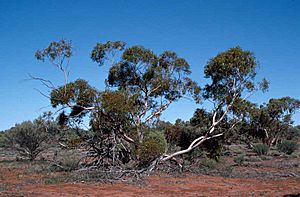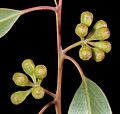Victoria Desert mallee facts for kids
Quick facts for kids Victoria Desert mallee |
|
|---|---|
 |
|
| Eucalyptus concinna near Cook, S.A. | |
| Scientific classification | |
| Genus: |
Eucalyptus
|
| Species: |
concinna
|
| Synonyms | |
|
|
The Victoria Desert mallee, also known as Eucalyptus concinna, is a special type of tree or large bush found only in Australia. It usually has rough, grey-brown bark on the bottom part of its trunk and smooth bark higher up. This plant has long, narrow adult leaves, white flowers, and cup-shaped fruits. You can find it mostly in the Great Victoria Desert area, across South Australia and Western Australia.
Contents
What Does the Victoria Desert Mallee Look Like?
The Victoria Desert mallee is a type of mallee plant. It usually grows up to 6 meters (about 20 feet) tall. Sometimes, it can even become a small tree, reaching 8 meters (about 26 feet) high. This plant has a special woody swelling at its base called a lignotuber. This helps it regrow after fires.
Bark and Leaves
The lower part of the trunk has rough, thick, grey-brown bark. Higher up, the bark is smooth and can be pale grey or even a coppery color.
Young plants have square-shaped stems. Their leaves are egg-shaped to broadly lance-shaped. Adult leaves are shiny green and arranged alternately. They are long and narrow, shaped like a spear.
Flowers and Fruit
The flower buds grow in groups of seven, nine, or eleven. They are found where the leaves meet the stem. Before flowering, the buds are often orange or red. The flowers are white and can bloom at different times, often after rain.
After the flowers, the plant produces woody, cup-shaped fruits. These fruits are also called capsules.
How Was This Plant Named?
The Victoria Desert mallee, Eucalyptus concinna, was first officially described in 1929. Two botanists, Joseph Maiden and William Blakely, gave it its scientific name. They studied a sample collected by Richard Helms in 1891.
The word concinna comes from Latin. It means "well-arranged," "beautiful," or "striking." This name probably describes the plant's neat shape and overall look.
Where Does the Victoria Desert Mallee Grow?
This mallee grows in sandy areas. You can find it in red sand or red clayey sand. It lives in sandplains or sandhill regions.
It is found across the Goldfields-Esperance and Mid West parts of Western Australia. It also grows in the western part of South Australia, reaching as far east as the Gawler Ranges.
Is the Victoria Desert Mallee Protected?
The Western Australian Government's Department of Parks and Wildlife has looked into the status of this eucalypt. They have classified it as "not threatened." This means it is not currently at risk of disappearing.
Images for kids



